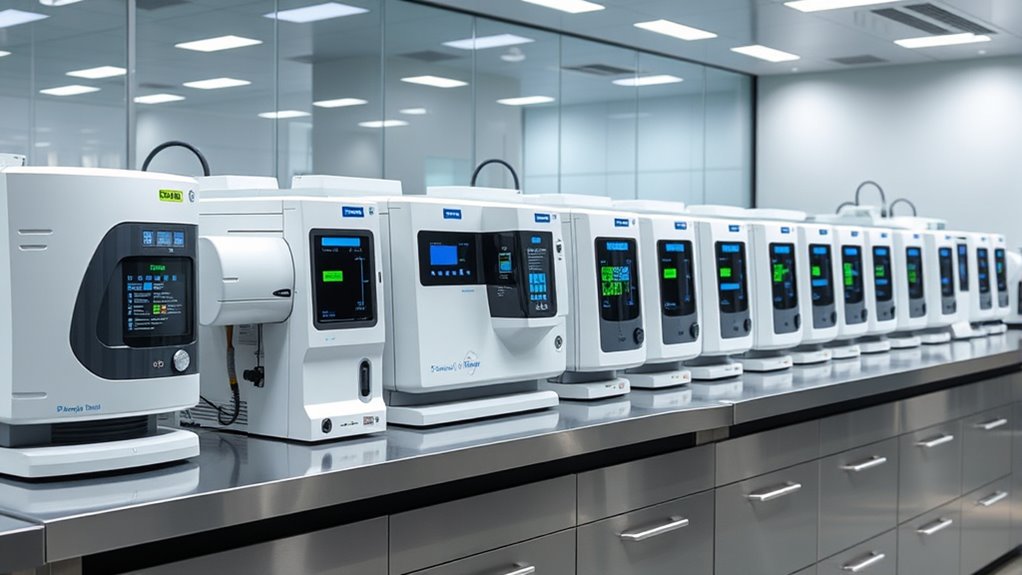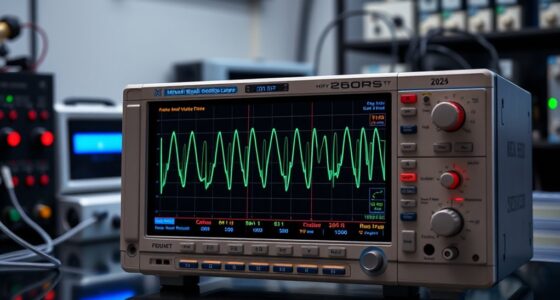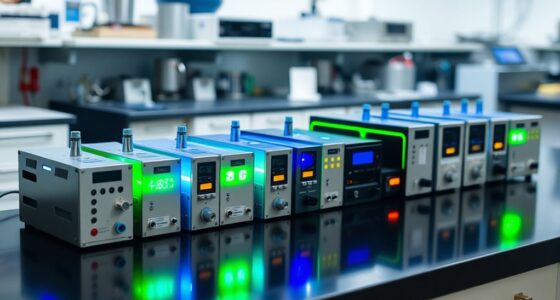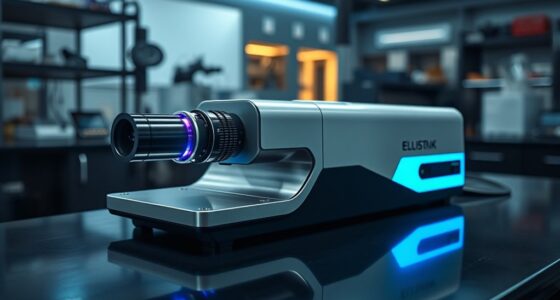If you’re searching for the top mass spectrometers in 2025, I recommend considering models that balance high precision, reliability, and user-friendly features. The best options include advanced instruments like the Ocean Optics USB2000+ and versatile spectrometers with digital, wireless, and automated capabilities. They’re perfect for detailed analytical work across various labs. Keep exploring further, and you’ll uncover the details that help you select the ideal instrument for your needs.
Key Takeaways
- Highlight top-rated mass spectrometers with advanced accuracy, sensitivity, and stability suitable for laboratory research in 2025.
- Include models featuring high-resolution capabilities, broad mass ranges, and reliable performance for diverse scientific applications.
- Emphasize instruments with cutting-edge technology such as nano-spectrometry, high repeatability, and integrated data management.
- Consider devices designed for specific fields like proteomics, metabolomics, or environmental analysis to match lab needs.
- Focus on brands and models known for innovation, durability, and precise measurement in professional laboratory settings.
EISCO Premium Quantitative Spectroscope
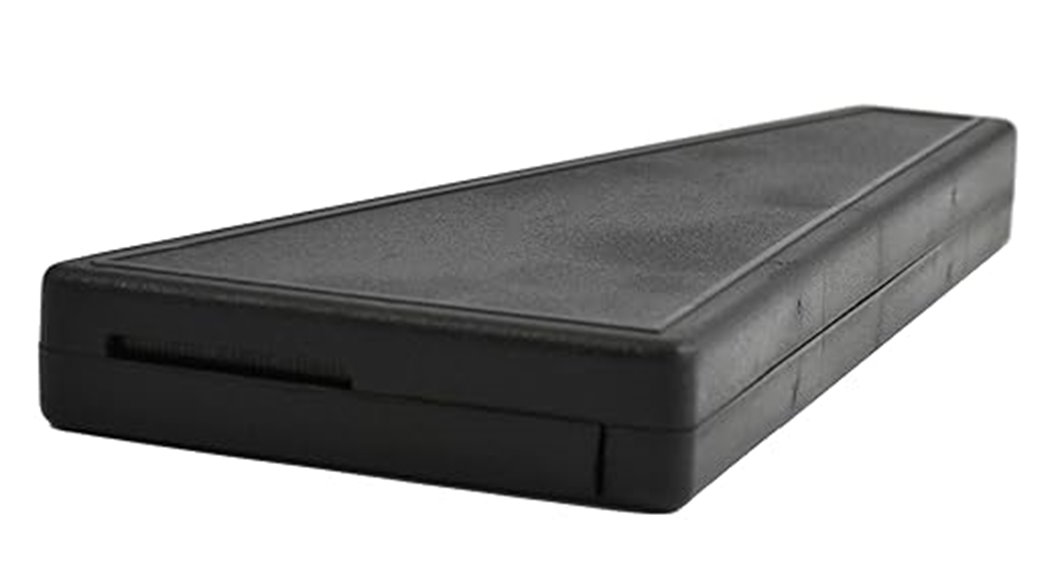
If you’re looking for a versatile spectroscope that delivers precise spectral measurements, the EISCO Premium Quantitative Spectroscope is an excellent choice. It’s perfect for studying light sources, analyzing color spectra, and conducting detailed experiments like flame tests and gas tube analysis. Its wide measurement range of 400.0 to 700.0nm covers the entire visible spectrum, ensuring exhaustive analysis. The innovative design includes a secure holder for the diffraction grating and scale, providing clear, reliable readings without adjustments. Equipped with a high-resolution 500 lines/mm diffraction grating, it offers sharp observations. With an accuracy of +/- 5.0nm, it guarantees dependable results for scientific research and experiments.
Best For: educators, students, and researchers seeking precise and versatile spectral analysis tools for experiments, astronomy, and light source studies.
Pros:
- Wide measurement range of 400.0 to 700.0nm for comprehensive spectral coverage
- High-resolution 500 lines/mm diffraction grating for sharp, detailed observations
- Secure holder and scale design ensure clear, reliable readings without adjustments
Cons:
- Slight measurement accuracy tolerance of +/- 5.0nm may affect highly sensitive experiments
- May require careful handling to prevent diffraction grating damage
- Not suitable for analyzing wavelengths outside the visible spectrum
Spectro 1 Mobile Spectrophotometer for Paint Color Matching

Looking for a portable device that delivers quick, accurate paint color matches on the spot? The Spectro 1 Mobile Spectrophotometer is ideal for on-the-go color calibration, acting as a checker, reader, and scanner. It can scan flat surfaces for instant color matches, reflectance curves, and detailed data. Compatible with major color libraries like Sherwin-Williams, Pantone, and RAL, it boosts design precision. Weighing just 8 ounces and featuring wireless connectivity via iOS and Android apps, it’s perfect for fieldwork. While praised for accuracy and ease of use, some users report durability issues and calibration challenges over time.
Best For: professionals in the field of painting, printing, or design who need portable, precise color matching solutions for on-the-spot color calibration.
Pros:
- Highly accurate spectral measurements with consistent repeatability
- Portable design weighing only 8 ounces for easy field use
- Compatibility with major color libraries like Sherwin-Williams, Pantone, and RAL for versatile applications
Cons:
- Some users experience durability issues and calibration failures over time
- Battery life and connectivity can be problematic after extended use
- Limited data export options and challenges in extracting detailed reflectance data
Handheld Spectrometer for Light Measurement (340-1000nm) with APP & PC Software
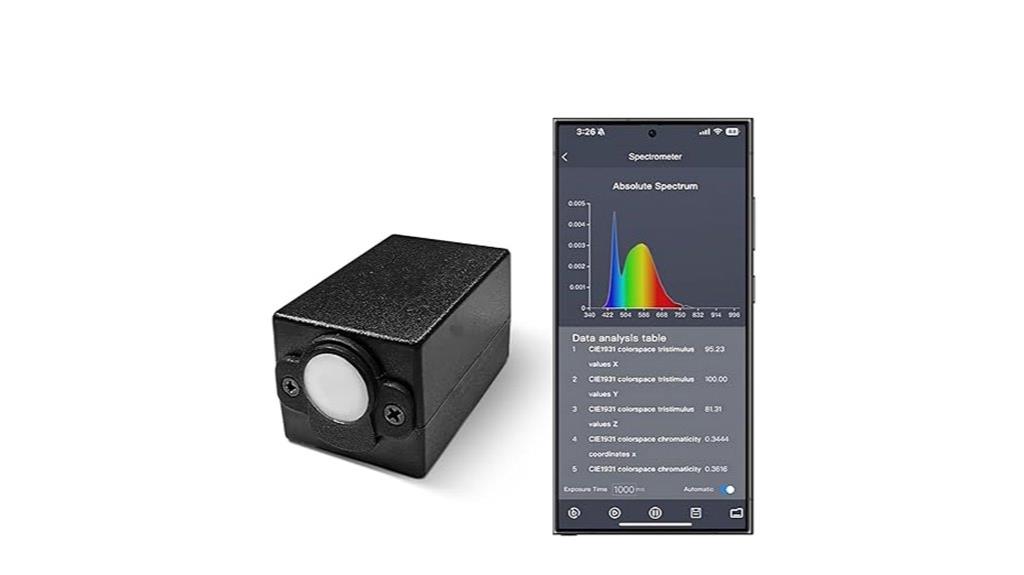
For professionals who need precise light measurement on the go, the handheld spectrometer with a 340-1000nm range stands out due to its compact design and real-time data capabilities. Weighing just 23 grams and measuring 47x28x25mm, it’s ultra-light and portable, perfect for fieldwork and on-site testing. Its USB Type-C connection guarantees stable, instant measurements via Android devices, while the dedicated app simplifies operation. The device accurately evaluates lighting performance, color rendering, and plant growth metrics like PAR and PPFD. With PC software for easy data analysis, reporting, and exporting, it’s a versatile tool for indoor lighting, agriculture, and research professionals.
Best For: professionals and researchers needing portable, accurate light measurement and analysis in the field, including those in horticulture, lighting design, and laboratory testing.
Pros:
- Compact and lightweight design (23g, 47x28x25mm) for easy portability and on-the-go use
- Real-time measurement capabilities with stable USB Type-C connection to Android devices
- Versatile measurement functions for CCT, CRI, PAR, PPFD, and broad spectrum analysis supporting multiple industries
Cons:
- Limited to light measurement within the 340-1000nm range, not suitable for other spectral analysis needs
- Requires compatible Android device for operation, potentially limiting use with other platforms
- Reliance on app and PC software may require user familiarity with digital interfaces and data management
Portable Spectrometer with CCT Meter and High Precision Sensor
https://m.media-amazon.com/images/I/51cK+kLuqzL._SX522_.jpg
The Portable Spectrometer with CCT Meter and High Precision Sensor stands out for its compact design and real-time measurement capabilities, making it ideal for lighting professionals who need quick, accurate readings on the go. Weighing just 450g and featuring a 3.5-inch touch screen, it offers effortless operation with a single button. It measures a wide range of parameters, including CCT, CRI, Lux, spectral distribution, and color ratios, ensuring extensive light analysis. Its trusted sensors deliver instant, reliable results for LED, CFL, and HID sources. Perfect for on-site testing, its portability doesn’t compromise precision, making it a valuable tool for any lighting assessment.
Best For: lighting professionals and technicians needing portable, accurate, and quick light measurements on-site for LED, CFL, and HID sources.
Pros:
- Compact and lightweight design for easy portability and on-the-go use
- Wide measurement parameters including CCT, CRI, spectral distribution, and color ratios for comprehensive analysis
- User-friendly interface with a 3.5-inch touch screen and one-button operation for quick measurements
Cons:
- Limited to basic color temperature and rendering index measurements, not suitable for advanced spectroscopic analysis
- Battery life may be limited for extended outdoor testing without recharge options
- May require calibration for highly precise laboratory-grade measurements
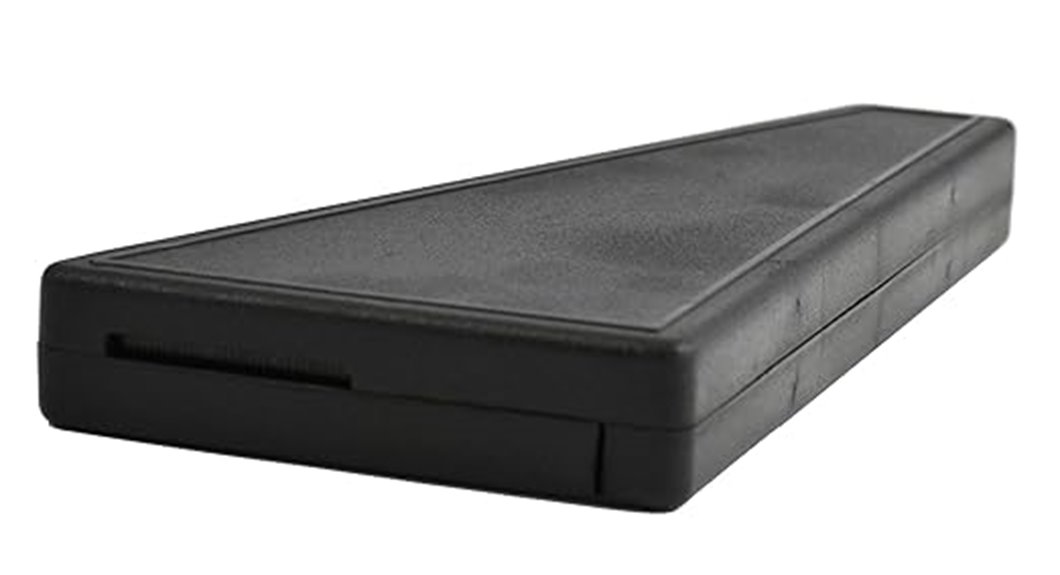
The EISCO Premium Quantitative Spectroscope stands out as an ideal choice for educators and students seeking an affordable yet reliable instrument for basic spectroscopy experiments. It covers a wavelength range of 400-700nm with a 5nm accuracy, perfect for classroom analysis of light sources, flame tests, and emission spectra. Its durable design ensures stable readings, and the separate illuminated wavelength scale makes data collection straightforward. While not suited for high-precision research, it offers a clear view of spectral lines and bands, making it a valuable educational tool. Overall, it combines simplicity, durability, and functionality at an accessible price point.
Best For: educators and students seeking an affordable, reliable spectroscope for basic classroom experiments and spectral analysis.
Pros:
- Durable construction with stable, clear readings.
- Separate illuminated wavelength scale for easy data collection.
- Suitable for analyzing a wide range of light sources within 400-700nm.
Cons:
- Limited accuracy of ±5nm may not be suitable for high-precision research.
- Some users experience difficulty with scale focus, especially older or farsighted individuals.
- The device may produce full spectra without detailed variation, restricting precise wavelength determination.
Spectrophotometer Color Spectrometer with Digital Display
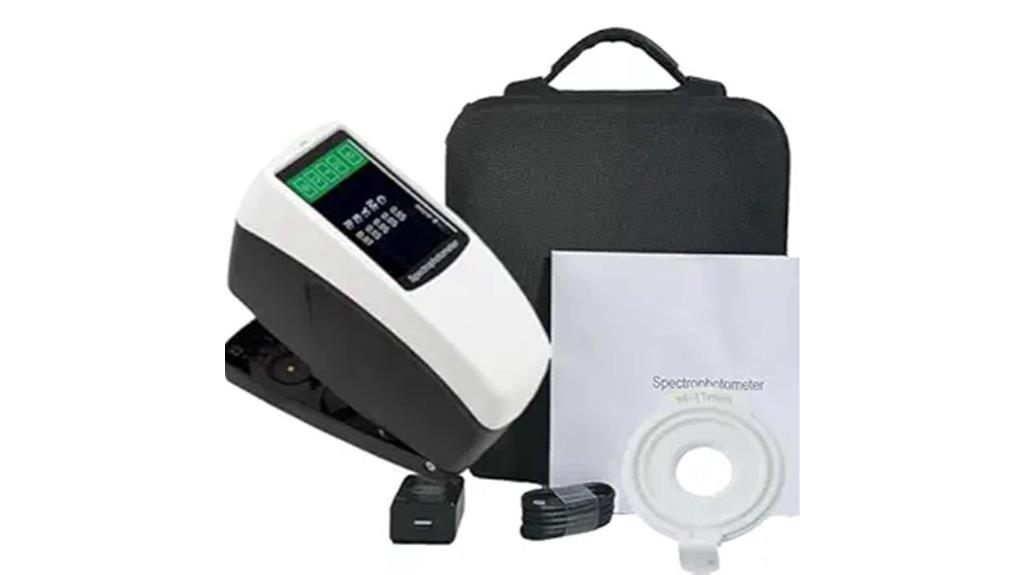
A spectrophotometer color spectrometer with a digital display is an essential tool for labs demanding high accuracy and real-time measurement verification. Its Φ11mm measuring aperture and horizontal, low-center-of-gravity design ensure stability and precision during testing. The built-in observation window allows for visual confirmation, reducing measurement errors. With ultra-high repeatability (dE*ab ≤ 0.02) and advanced nano-spectrophotometer technology, it delivers consistent, reliable results. Supporting over 30 measurement parameters and nearly 40 light sources, it caters to diverse industry needs. The device’s data storage and Windows-based software facilitate thorough color management, compliance, and easy data handling, making it a versatile, high-performance instrument.
Best For: professionals and laboratories requiring precise, real-time color measurement and verification across various industries.
Pros:
- Ultra-high repeatability accuracy (dE*ab ≤ 0.02) ensures reliable results.
- Supports over 30 measurement parameters and nearly 40 light sources for versatile applications.
- Built-in observation window and stable design reduce measurement errors and enhance precision.
Cons:
- May require technical training to fully utilize advanced features and software.
- The device’s size and complexity might not be ideal for quick, on-the-go measurements.
- Higher cost compared to simpler color measurement tools due to its advanced capabilities.
Eisco Labs High Quality, Standard Spectrometer – Model PH0619
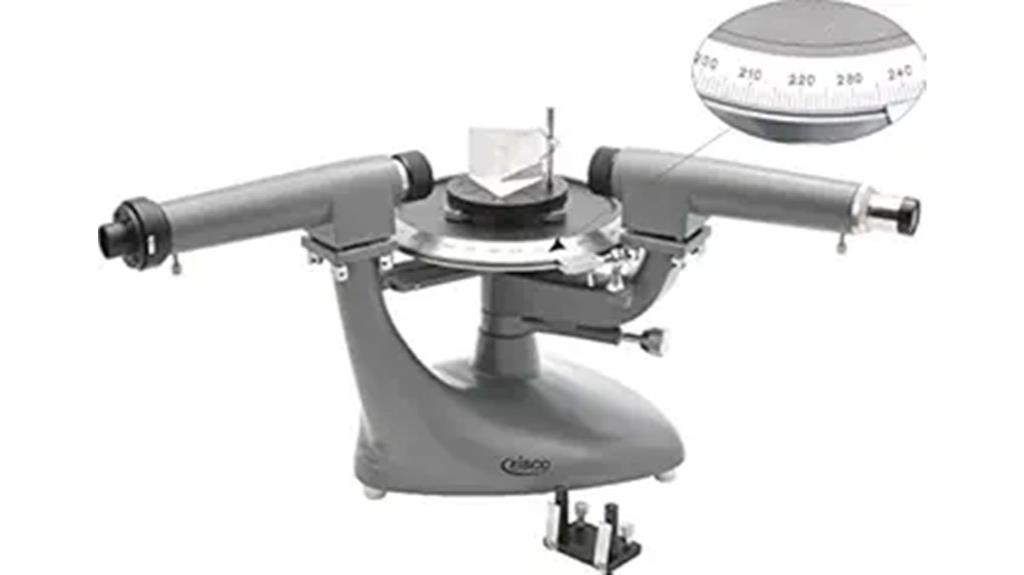
If you’re looking for a reliable spectrometer that combines durability with precise optical measurements, the Eisco Labs High-Quality Spectrometer Model PH0619 stands out as an excellent choice for educational labs. It offers smooth 0-360° rotation with 1° graduations and a 0.1° vernier scale for accurate readings. Built with heavy castings, the instrument guarantees durability and stability during experiments. Its optical components, including an adjustable collimator and achromatic telescope with fine adjustments, allow precise spectral analysis. Complete with accessories like a prism table and diffraction grating holder, it’s perfect for teaching light spectra, refraction, and diffraction in classroom or hobbyist settings.
Best For: educators, students, and hobbyists seeking a durable, precise spectrometer for classroom experiments and optical demonstrations.
Pros:
- Robust construction with heavy castings ensures durability and stability during use
- Precise optical features like 0-360° rotation and a 0.1° vernier scale allow accurate measurements
- Versatile accessories, including prism and diffraction grating holders, facilitate various optical experiments
Cons:
- Requires separate prism for spectral analysis, adding to overall cost
- May be too large or heavy for portable or field applications
- Designed primarily for educational purposes, which might limit advanced research use
Light Spectrum Meter, Portable CCT and CRI Spectrometer
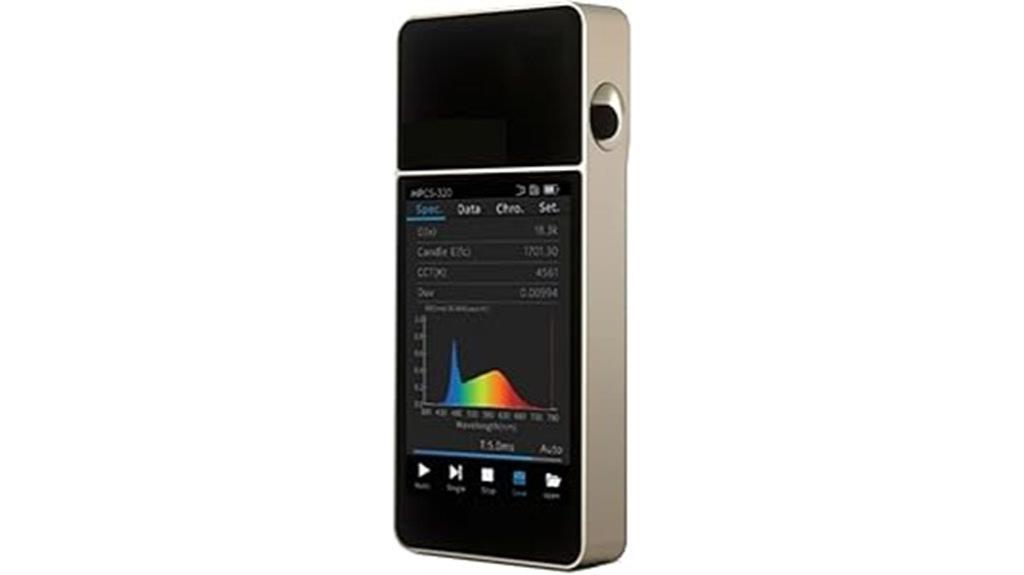
For lighting professionals seeking a portable yet accurate spectrometer, the Light Spectrum Meter, Portable CCT and CRI Spectrometer offers a compelling solution. It’s compact, lightweight, and easy to use, with a 3.5-inch touch screen that displays real-time measurements of spectral irradiance, CCT, CRI, Lux, Duv, and color coordinates. Suitable for LED, CFL, and HID sources, it delivers fast, reliable results across a 380-780nm range. Its user-friendly one-button operation and integrated spectrum analysis make it ideal for on-site testing, quality control, and basic lighting assessments. Weighing just 450g, it’s perfect for professionals needing accurate, affordable spectral measurements in the field.
Best For: lighting professionals who need a portable, accurate, and user-friendly spectrometer for on-site measurement of CCT, CRI, and spectral distribution.
Pros:
- Compact and lightweight design for easy portability in field settings
- Real-time measurement display with a user-friendly 3.5-inch touch screen
- Wide measurement range (380-780nm) suitable for various light sources including LED, CFL, and HID
Cons:
- Limited to basic spectral and color measurements; may not suit advanced diagnostics
- Battery life details are not specified, which could impact long-term use in the field
- May require calibration or additional accessories for more detailed spectral analysis
M Spectrometer
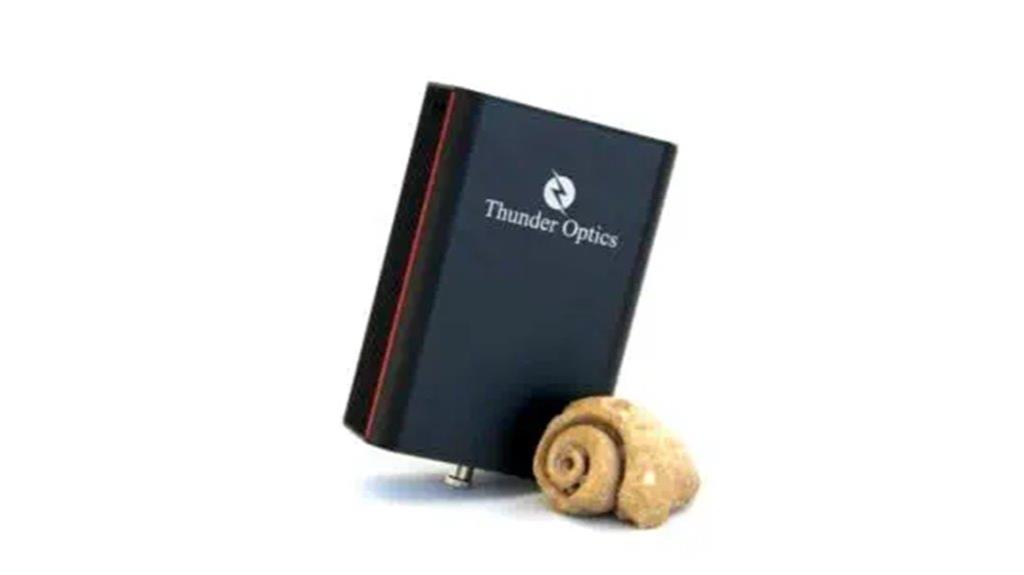
The M Spectrometer stands out as an ideal choice for researchers demanding high sensitivity and precise spectral measurements. Its 100µm slit and SMA connector guarantee high-quality data collection, making it perfect for detailed analysis. The monochrome detector covers a broad 360-880nm wavelength range, offering exceptional sensitivity to light and accurate detection of spectral lines. Enhanced performance features like extended depth of focus and improved accuracy support complex research tasks. As an upgraded version of the C Spectrometer, it combines reliability with versatility, enabling scientists to explore molecular phenomena with confidence. This instrument truly elevates spectral analysis capabilities in any advanced laboratory setting.
Best For: researchers and scientists requiring high-sensitivity, precise spectral analysis for molecular spectroscopy and related scientific investigations.
Pros:
- High sensitivity with a broad 360-880nm wavelength range for accurate spectral detection
- Enhanced performance features like extended depth of focus and improved accuracy for complex measurements
- Reliable and versatile design suitable for advanced research applications
Cons:
- May require specialized training to operate at optimal levels
- Potentially higher cost due to advanced features and calibration
- Limited to spectral measurements within the 360-880nm range, not suitable for other spectral regions
Advanced Spectrometer with Light Measurement Tool
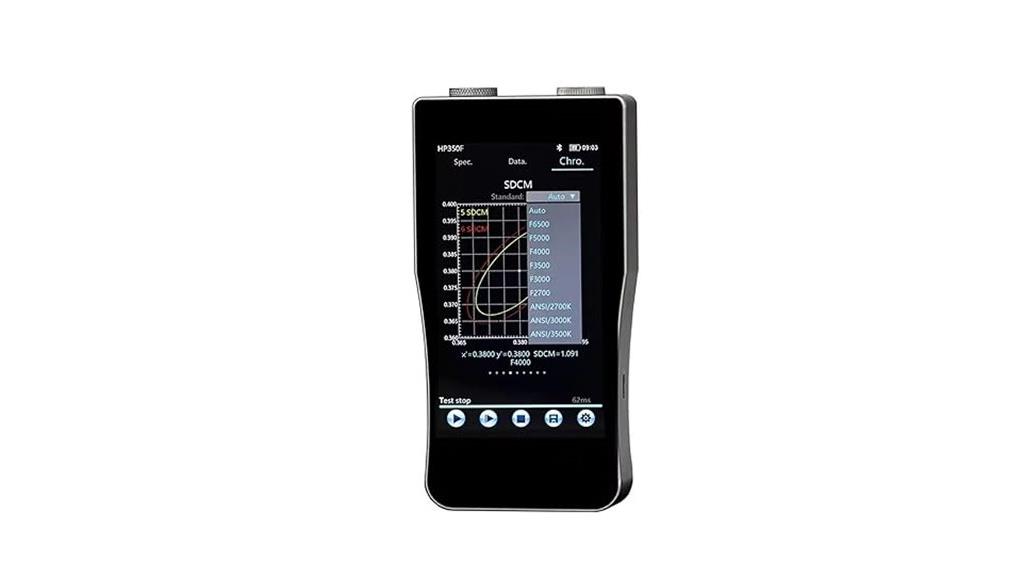
An advanced spectrometer equipped with a thorough light measurement tool is an ideal choice for laboratories that require precise and versatile light analysis. It measures spectrum, flicker, strobe frequency, CCT, CRI, lux, and PAR, providing extensive light data. Its flicker detection covers both visible and invisible flicker, ensuring safety and high-quality lighting. With lab-grade sensors, it delivers professional-level accuracy comparable to benchtop instruments. Wireless connectivity allows real-time data transfer to computers and smartphones, facilitating immediate analysis and reporting. This device is perfect for LED manufacturing, film production, architectural lighting, and scientific research, offering robust performance across diverse applications.
Best For: professionals in laboratories, LED manufacturing, film production, architectural lighting, and scientific research seeking precise, versatile, and real-time light measurement and analysis.
Pros:
- Provides comprehensive light data including spectrum, flicker, CCT, CRI, lux, and PAR
- Detects both visible and invisible flicker for enhanced safety and quality
- Wireless connectivity enables instant data transfer and real-time analysis
Cons:
- May be more expensive than basic light measurement tools
- Requires familiarity with advanced light analysis for optimal use
- Potentially complex setup for users unfamiliar with spectrometry equipment
UV-5100B UV/VIS Spectrophotometer with Auto Wavelength Setting

If you’re seeking a spectrophotometer that offers precise measurements with minimal user error, the UV-5100B UV/VIS Spectrophotometer with Auto Wavelength Setting stands out. It covers a wavelength range of 190-1000nm and features automatic wavelength adjustment via arrow keys, reducing operational mistakes. Its high-quality, rigid construction ensures stability and low stray light, boosting measurement accuracy. With a USB port for easy PC connection, it displays spectra, kinetics, and multi-wavelength results. You can establish standard curves, determine unknown concentrations, and store up to 200 results. Overall, it combines durability, precision, and efficient data handling for reliable spectrophotometric analysis.
Best For: researchers and laboratory professionals seeking precise, reliable spectrophotometric analysis with minimal operation errors.
Pros:
- Automatic wavelength setting minimizes user errors and enhances measurement efficiency.
- Low stray light and high-quality construction ensure accurate and stable results.
- USB connectivity allows easy data transfer and storage of up to 200 results.
Cons:
- Optional software may require additional purchase or setup.
- Limited to spectrophotometric analysis within the 190-1000nm range, which may not suit all applications.
- The device’s complexity might require training for optimal operation.
HPCS-330P Wireless Spectrometer PPFD PAR Quantum Meter with Bluetooth

For professionals seeking a portable and highly versatile light measurement tool, the HPCS-330P Wireless Spectrometer PPFD PAR Quantum Meter with Bluetooth stands out. Its wireless Bluetooth connection and detachable sensor make it flexible for various testing environments. Compact and lightweight, it easily slips into a pocket or work bag, perfect for on-the-go measurements. It measures PPFD, PAR, lux, CCT, and CRI across a wavelength range of 350 to 800 nm with high accuracy. Data can be saved directly on the device and exported as Excel files, with PC software support for detailed analysis. Users appreciate its ease of use, mobility, and all-encompassing measurement capabilities.
Best For: professionals and hobbyists seeking a portable, versatile light measurement device for grow light testing and general illumination analysis.
Pros:
- Wireless Bluetooth connectivity with detachable sensor for flexible use.
- Compact, lightweight design ideal for on-the-go measurements and tight spaces.
- Supports data saving, export to Excel, and PC software for detailed analysis.
Cons:
- Limited to a wavelength range of 350 to 800 nm, which may not cover all light spectrum needs.
- Requires Bluetooth connection, which might be problematic in environments with interference.
- Battery life details are not specified, potentially limiting prolonged outdoor or remote use.
Pocket-Sized Handheld Diffraction Spectroscope
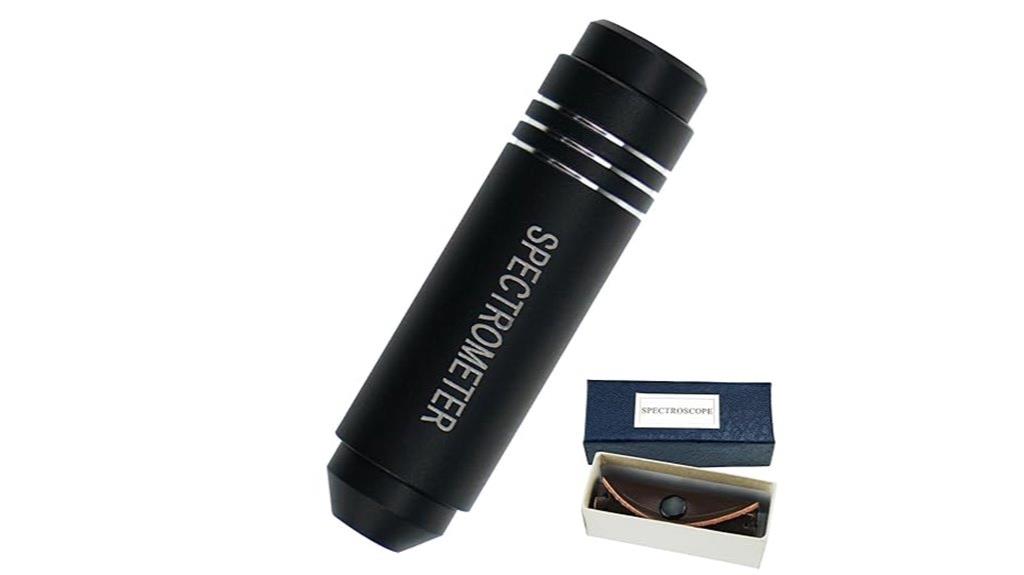
The pocket-sized handheld diffraction spectroscope stands out as an essential tool for gemologists, collectors, and travel enthusiasts who need quick, reliable gemstone identification on the go. Made from aircraft aluminum with premium optics, it offers durability and accurate results in various environments. Its high-quality grating detects gemstones like YAG and Cubic Zirconia, as well as iron and chromium presence, helping distinguish different stones. The device displays absorption spectra as vertical black lines, serving as unique fingerprints for each gemstone. Compact and easy to operate, it’s perfect for enhancing gem analysis skills during travel, trade shows, or personal exploration.
Best For: gemologists, collectors, and travel enthusiasts needing quick, accurate gemstone identification in various environments.
Pros:
- Portable and compact design for easy transportation during travel or fieldwork
- Made from durable aircraft aluminum with premium optics for reliable performance
- Capable of detecting specific gemstones and mineral elements like YAG, Cubic Zirconia, iron, and chromium
Cons:
- Does not include gemstones, requiring users to have samples on hand for testing
- May require some basic knowledge to interpret absorption spectra effectively
- Limited to gemstone identification and cannot provide detailed chemical analysis
Generic Used Ocean Optics USB2000+ Spectrometer

The Generic Used Ocean Optics USB2000+ Spectrometer is an excellent choice for labs seeking a reliable, ready-to-use optical device. Its wavelength range of 340.45 to 1023.43 nm covers a broad spectrum, ideal for various applications. The 050 slit size ensures precise spectral resolution. Thanks to its plug-and-play USB connectivity, setup is straightforward—just connect to your computer for instant operation. It’s tested for functionality and performance, so you can trust its reliability. Keep in mind, if you’re concerned about tariffs, check for potential customs duties after payment. Overall, this spectrometer offers solid performance at a competitive price point.
Best For: researchers and lab technicians seeking a reliable, easy-to-use spectrometer for broad-spectrum optical measurements.
Pros:
- Plug-and-play USB connectivity for quick setup and operation
- Wide wavelength range from 340.45 to 1023.43 nm suitable for diverse applications
- Tested for functionality and performance ensuring reliability
Cons:
- Used condition may mean some wear or prior usage marks
- Slit size of 050 may limit extremely high-resolution measurements
- Potential customs duties depending on U.S. tariff policies after purchase
United Scientific DFG600 Diffraction Gratings for SPECT01 Spectrometer
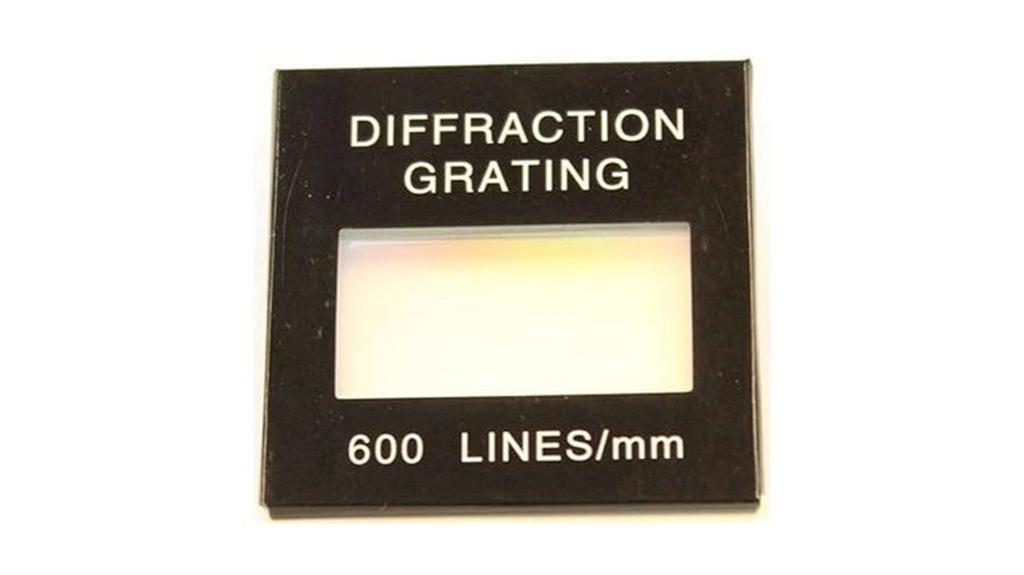
United Scientific DFG600 diffraction gratings are an affordable choice for educators and amateur scientists seeking a basic tool to split light in spectroscopic experiments. With 600 lines per millimeter, they fit the SPECT01 spectrometer, providing a straightforward way to observe light dispersion. The gratings are protected by dual glass plates, enhancing durability and visibility. While suitable for simple demonstrations and sunlight experiments, their optical quality is limited. Users report issues like scratches, fingerprints, and smeared spectral lines, which hinder detailed analysis. Despite some quality concerns, these gratings offer a budget-friendly option for educational purposes, though they’re less ideal for high-precision spectroscopy.
Best For: educators and amateur scientists seeking an affordable, basic diffraction grating for introductory light dispersion experiments.
Pros:
- Cost-effective option suitable for educational use
- Compatible with the SPECT01 spectrometer for straightforward setup
- Protected by dual glass plates to improve durability and visibility
Cons:
- Optical quality limited, with smeared spectral lines and less precision
- Common issues include scratches, fingerprints, and misalignment
- Not ideal for high-accuracy spectroscopy or detailed light analysis
Factors to Consider When Choosing Mass Spectrometers for Labs
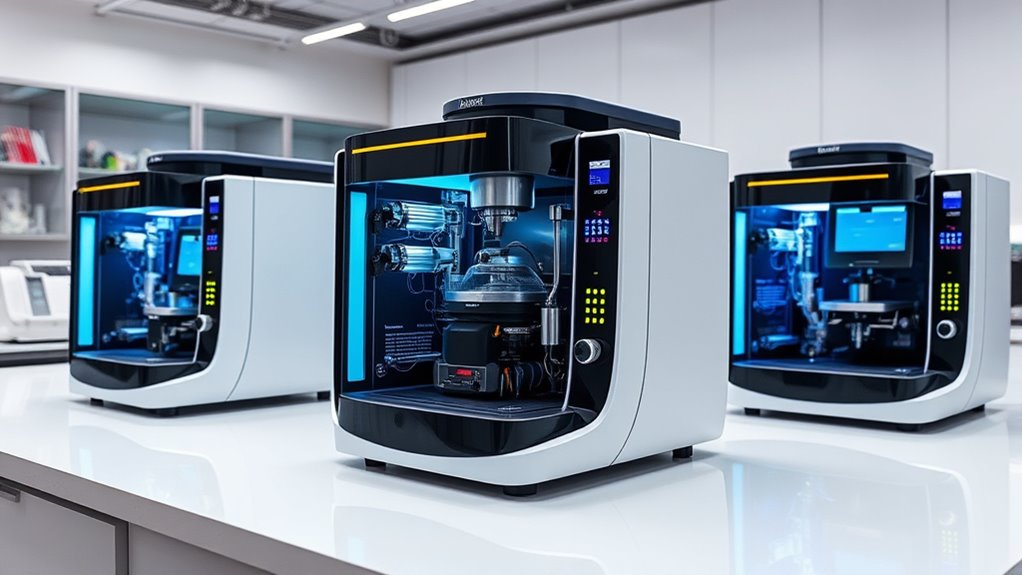
When selecting a mass spectrometer, I focus on key factors like sensitivity, accuracy, and ease of use to guarantee it fits my lab’s needs. Cost and durability also play a vital role in making a practical, long-term investment. Considering these points helps me choose equipment that delivers reliable results and fits within my budget.
Sensitivity and Range
Choosing the right mass spectrometer hinges on understanding its sensitivity and range, as these factors directly influence its suitability for specific analytical tasks. Sensitivity determines how well the instrument detects and quantifies low-abundance ions, which is critical for trace analysis. Achieving high sensitivity often involves optimized ionization sources and detector configurations to reduce background noise and enhance signal clarity. Range refers to the mass-to-charge (m/z) values the instrument can measure, typically spanning from a few Daltons to thousands, enabling analysis of everything from small molecules to large biomolecules. Balancing sensitivity and range ensures accurate, reliable measurements tailored to your lab’s needs. Understanding these two factors helps you select a spectrometer that delivers precise results across diverse sample types and analytical requirements.
Accuracy and Precision
Understanding the accuracy and precision of a mass spectrometer is essential for selecting the right instrument for your lab. Accuracy is indicated by a low parts-per-million (PPM) error rate, with top models achieving less than 2 PPM, ensuring reliable identification of compounds. Precision reflects an instrument’s ability to produce consistent results, often measured by low standard deviations across repeated analyses. Regular calibration with known standards is indispensable, especially when analyzing complex or unknown samples, to maintain accuracy. Additionally, the resolution—measured in m/∆m—determines how well the instrument distinguishes between ions with similar masses, directly affecting precision. Proper maintenance and tuning are imperative for sustained accuracy and precision, ensuring your lab’s results remain dependable over time.
Ease of Operation
Ease of operation is a critical factor that can substantially impact a lab’s productivity and accuracy. A user-friendly mass spectrometer features intuitive interfaces like touchscreen controls and simplified menus, reducing the need for extensive training. Devices with automated sample introduction and calibration processes make operation straightforward, minimizing manual handling and potential errors. Clear, step-by-step instructions and visual guides within the software or device interface help users perform analyses confidently without specialized technical knowledge. Additionally, models with preset analysis methods and customizable workflows streamline experiments, saving time and improving consistency. User-friendly data output formats and integrated reporting tools facilitate quick interpretation and sharing of results. Overall, choosing an easy-to-operate instrument enhances operational efficiency and allows lab personnel to focus on analysis rather than troubleshooting.
Data Management Features
Effective data management is essential when selecting a mass spectrometer for your lab, as it directly impacts workflow efficiency and data integrity. Look for models with integrated data storage to securely save large datasets directly on the device, reducing reliance on external storage. Compatibility with software that exports data in formats like CSV, Excel, or PDF makes analysis and reporting straightforward. Connectivity options such as Bluetooth, USB, and Wi-Fi enable seamless transfer to computers, tablets, or smartphones, saving time and minimizing errors. Real-time data visualization and on-screen displays allow immediate interpretation during experiments, speeding up decision-making. Additionally, robust data management software supporting all-encompassing analysis, calibration, and integration with laboratory information systems ensures your data remains organized, accessible, and reliable throughout your research process.
Cost and Durability
Choosing the right mass spectrometer involves balancing initial costs with long-term durability. Basic models can cost a few thousand dollars, while high-end systems may exceed $100,000. Durability depends on build quality; robust materials like stainless steel and reinforced parts make units more resistant to wear and tear. A well-made spectrometer can last 10 years or more with proper maintenance and a stable environment. Investing in a durable system might have a higher upfront cost but can reduce long-term expenses by cutting down on repairs, replacements, and downtime. Cheaper options may be less durable and less precise, which could be suitable for educational or less demanding applications. Ultimately, weighing upfront costs against longevity helps ensure a smart, cost-effective choice.
Frequently Asked Questions
How Do Different Mass Spectrometers Compare in Sensitivity and Resolution?
Different mass spectrometers vary considerably in sensitivity and resolution. I find that time-of-flight (TOF) instruments excel in speed and high resolution, making them ideal for complex samples. Quadrupole MS units are versatile but often have moderate sensitivity. When I need ultra-high resolution and sensitivity, I prefer Orbitrap or FTICR systems, as they provide detailed, precise data essential for advanced research.
What Maintenance Is Required for High-Precision Lab Mass Spectrometers?
Maintaining high-precision lab mass spectrometers involves regular calibration, cleaning, and software updates. I check the vacuum systems and replace worn-out parts like filaments or detectors to guarantee accuracy. It’s also crucial to run diagnostic tests periodically to catch issues early. Plus, I keep detailed maintenance logs. Consistent upkeep minimizes downtime, prolongs instrument life, and assures reliable, high-quality results essential for advanced research and precise measurements.
Which Features Are Most Important for Portable Versus Benchtop Mass Spectrometers?
When choosing between portable and benchtop mass spectrometers, I focus on different features. For portable units, I prioritize lightweight design, battery life, and ease of use, so I can perform field analyses efficiently. With benchtop models, I look for high sensitivity, resolution, and advanced data processing capabilities to guarantee precision in a lab setting. Ultimately, the decision hinges on mobility needs versus analytical robustness.
How Do Cost and Performance Balance in Top Mass Spectrometer Models?
Imagine walking a tightrope between cost and performance—top models balance carefully on this line. In my experience, premium mass spectrometers offer unmatched precision but come with higher prices. Yet, some mid-range options deliver excellent results without breaking the bank. It’s about evaluating your needs; if you prioritize accuracy and sensitivity, investing more pays off. Otherwise, a cost-effective model might suffice for your lab’s goals.
What Are Common Troubleshooting Steps for Mass Spectrometer Accuracy Issues?
When my mass spectrometer shows accuracy issues, I start by checking the calibration and making sure it’s recent. I clean the ion source and check for any blockages or debris. I also verify the vacuum system’s integrity, ensuring there’s no leaks. Finally, I review the software settings and perform a test run. These steps usually help me pinpoint and fix the problem efficiently.
Conclusion
In choosing the perfect spectrometer, prioritize precision, portability, and performance. Picture pristine peaks, pinpoint accuracy, and powerful portability transforming your lab work. Whether you’re chasing clarity or craving cutting-edge capabilities, these top picks promise to propel your projects forward. With the right device, you’ll turn complex samples into crystal-clear insights, creating a confident, cutting-edge core for your lab’s future. Let these luminous tools light your way to scientific success.
